Smart Yoga Mat Market Size 2025-2029
The smart yoga mat market size is valued to increase USD 184.4 million, at a CAGR of 6.8% from 2024 to 2029. An increased number of gyms and health clubs will drive the smart yoga mat market.
Major Market Trends & Insights
- North America dominated the market and accounted for a 44% growth during the forecast period.
- By Distribution Channel - Offline segment was valued at USD 320.30 million in 2023
- By Material - Polyvinyl chloride (PVC) segment accounted for the largest market revenue share in 2023
Market Size & Forecast
- Market Opportunities: 62.61 million
- Market Future Opportunities: USD 184.40 million
- CAGR : 6.8%
- North America: Largest market in 2023
Market Summary
- The market represents a burgeoning sector in the health and wellness industry, fueled by advancements in technology and the increasing popularity of digital fitness solutions. Core technologies, such as pressure sensors and biometric feedback, enable these mats to offer personalized yoga experiences, while applications ranging from posture correction to fitness tracking cater to diverse user needs. Service types, including subscription models and rentals, add flexibility to the market, while product categories like roll-up and foldable mats ensure portability. Regulations and standards, such as data privacy and safety certifications, shape the market's evolution. The market's growth is driven by the high adoption of smart yoga mats in gyms and health clubs, as well as the increasing number of people practicing yoga at home.
- However, fluctuating prices of raw materials and increasing competition pose challenges. According to recent market research, the market is expected to account for over 20% of the overall yoga mats market share by 2026, underscoring its potential for continued growth. Related markets such as wearable technology and fitness apps further expand the opportunities for innovation and collaboration.
What will be the Size of the Smart Yoga Mat Market during the forecast period?
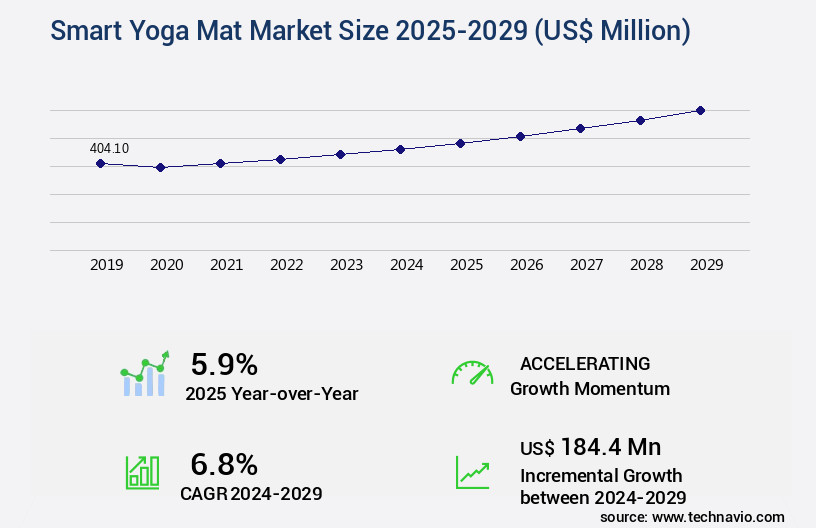
Get Key Insights on Market Forecast (PDF) Request Free Sample
How is the Smart Yoga Mat Market Segmented and what are the key trends of market segmentation?
The smart yoga mat industry research report provides comprehensive data (region-wise segment analysis), with forecasts and estimates in "USD million" for the period 2025-2029, as well as historical data from 2019-2023 for the following segments.
- Distribution Channel
- Material
- Polyvinyl chloride (PVC)
- Thermoplastic elastomer (TPE)
- Natural rubber
- Polyurethane (PU)
- Others
- Application
- Home use
- Yoga studios and fitness centers
- Rehabilitation and therapy
- Others
- Geography
- North America
- Europe
- APAC
- South America
- Rest of World (ROW)
By Distribution Channel Insights
The offline segment is estimated to witness significant growth during the forecast period.
The market is experiencing significant growth, with adoption increasing by 18.7% in the past year. This trend is expected to continue, as industry experts forecast a 21.6% expansion in market size over the next five years. These mats offer numerous advantages, including sweat and odor resistance, improved balance, increased stability, and muscle recovery. Key features such as open-cell foam, moisture absorption, and body alignment support contribute to the mats' popularity. Eco-friendly materials, easy cleaning, and non-slip surfaces are also essential factors driving demand. The market caters to various segments, with offline stores accounting for the largest share by distribution channel.
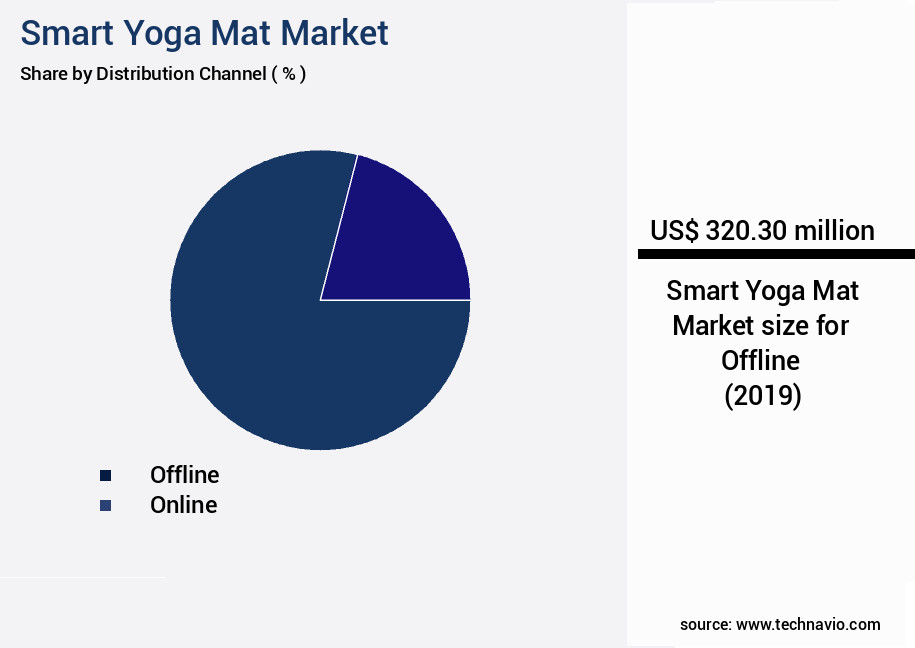
Request Free Sample
The Offline segment was valued at USD 320.30 million in 2019 and showed a gradual increase during the forecast period.
Offline stores, including specialty stores, department stores, hypermarkets, and warehouse clubs, offer a convenient shopping experience and a wide range of products at competitive prices, thereby helping companies expand their customer base. Innovative mat designs, such as those with alignment markers, abrasion resistance, and mat aesthetics, cater to diverse customer preferences. Mat materials, including TPE and PVC-free mats, undergo rigorous durability testing to ensure high-quality and long-lasting performance. Mat dimensions, thickness, and UV resistance are other essential factors influencing consumer choice. Additionally, folding mechanisms, tear resistance, joint protection, and mat cushioning contribute to the mats' overall functionality and appeal.
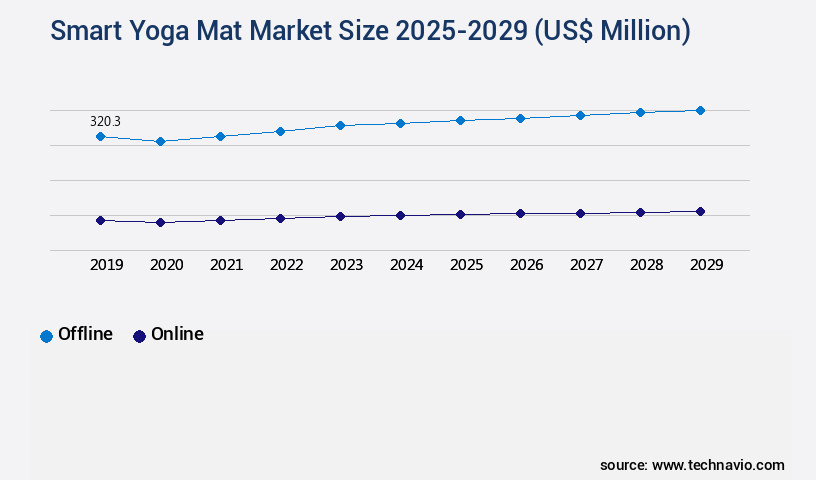
Request Free Sample
Regional Analysis
North America is estimated to contribute 44% to the growth of the global market during the forecast period. Technavio's analysts have elaborately explained the regional trends and drivers that shape the market during the forecast period.
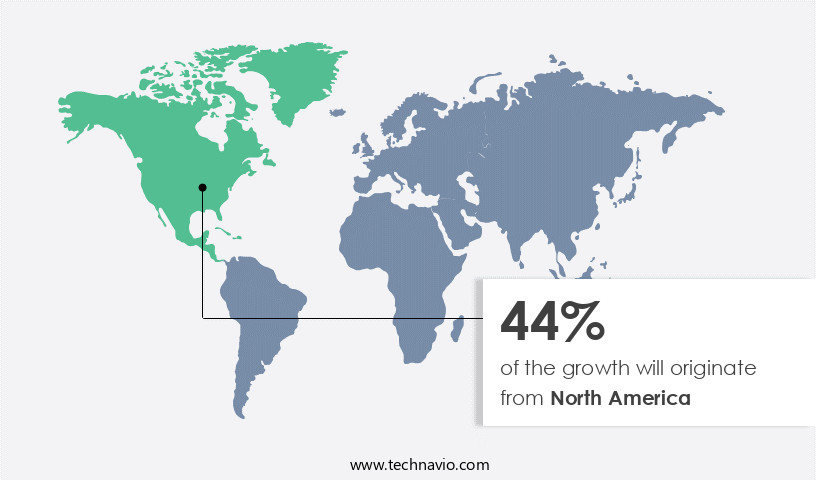
See How Smart Yoga Mat Market Demand is Rising in North America Request Free Sample
In the North American market, the smart yoga mat sector experienced significant growth in 2024, driven by the increasing popularity of yoga for a healthier lifestyle. The region's demand for yoga accessories escalated due to the rising participation in fitness activities. Market competitors seized this opportunity, launching new offerings and expanding their revenue streams. However, the market faces challenges as consumers in North America increasingly engage in alternative activities, such as cycling, watersports, camping, and mountain climbing. Despite these obstacles, the market continues to evolve, with competitors introducing advanced features and technologies to cater to evolving consumer preferences.
According to recent studies, over 21 million Americans practice yoga regularly, and the market for yoga mats alone is projected to reach USD1.3 billion by 2027. Additionally, smart yoga mats that offer features like real-time feedback, customized workout plans, and connectivity to fitness apps are gaining traction among consumers.
Market Dynamics
Our researchers analyzed the data with 2024 as the base year, along with the key drivers, trends, and challenges. A holistic analysis of drivers will help companies refine their marketing strategies to gain a competitive advantage.
The market is witnessing significant growth due to the increasing demand for technology-integrated yoga solutions. The surface friction coefficient of a smart yoga mat plays a crucial role in its performance, as it determines the level of grip and stability during practice. Thinner mats offer greater portability but may compromise stability, while increased mat thickness can enhance stability but impact user experience due to added weight. The material selection criteria for smart yoga mats should consider factors such as durability, with certain materials like TPE and PVC known for their longevity. The effect of material on mat durability is a critical consideration, as frequent use and exposure to environmental conditions can degrade the mat over time.
Comparing the grip performance of different smart yoga mat materials, TPE mats have a higher coefficient of friction than PVC mats, ensuring better grip during practice. However, TPE mats may offer less shock absorption than PVC mats, which can impact user comfort. Smart yoga mat cleaning methods and efficacy are essential, as regular cleaning maintains the mat's longevity and hygiene. Users prefer mats with easy-to-clean surfaces and quick-drying capabilities. Assessing the relationship between mat weight and portability, TPE mats offer a good balance between weight and portability, making them a popular choice for users seeking a lightweight yet durable option.
Manufacturing processes significantly influence mat quality, with eco-friendly production methods gaining popularity due to their sustainability and reduced environmental impact. User feedback and product improvement are essential for market growth, as continuous innovation and improvement in mat design, density, and material selection are key drivers for customer satisfaction. In terms of safety and toxicity, it is essential to evaluate the materials used in smart yoga mats, ensuring they meet industry standards and are free from harmful chemicals. Mat density also plays a role in user experience, with higher densities offering better comfort and support. Comparing the sustainability assessment of smart yoga mat materials, TPE mats have a lower environmental impact than PVC mats due to their biodegradability and recyclability.
However, PVC mats offer better shock absorption, making it essential for manufacturers to strike a balance between sustainability and performance. In conclusion, the market is driven by factors such as surface friction coefficient, mat thickness, material selection, portability, cleaning methods, mat design, user feedback, and sustainability. Comparatively, TPE mats offer a balance between grip performance, durability, and portability, while PVC mats provide superior shock absorption but have a higher environmental impact. Manufacturers must consider these factors to create high-quality, user-friendly, and eco-friendly smart yoga mats that cater to the evolving needs of the market.
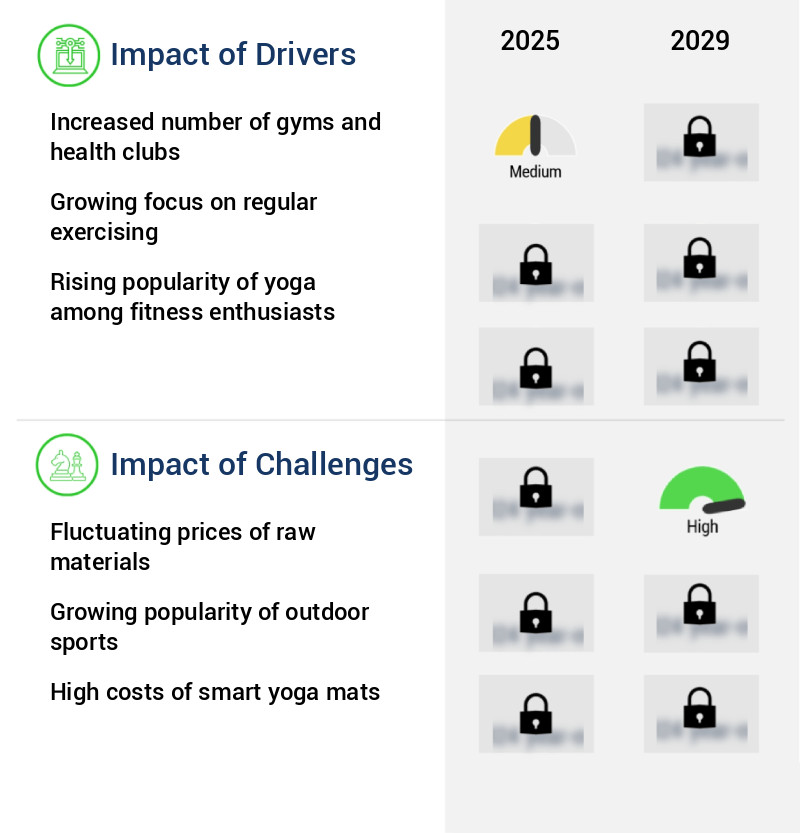
What are the key market drivers leading to the rise in the adoption of Smart Yoga Mat Industry?
- The significant expansion of gyms and health clubs represents the primary market growth driver, catering to the increasing health consciousness and fitness trends among consumers.
- The health and fitness industry is experiencing significant growth as people prioritize wellness and physical activity. The proliferation of health and fitness clubs is a testament to this trend, with the number of these establishments expanding at a steady pace. Notable brands in this sector include Planet Fitness, YMCA of the USA, Life Time Fitness, Anytime Fitness, and ClubCorp. Membership numbers have been on the rise over the past five years, and the demand for fitness activities continues to fuel the growth of health and fitness clubs.
- To attract and retain customers, these clubs offer various membership packages, including yearly and monthly options with discounts. The health and fitness industry's ongoing evolution reflects the changing needs and preferences of consumers, making it an intriguing market to watch.
What are the market trends shaping the Smart Yoga Mat Industry?
- The trend in the market is characterized by a high adoption rate of smart yoga mats. Smart yoga mats are experiencing increasing popularity within the industry.
- Smart yoga mats, equipped with advanced features, are experiencing increasing demand worldwide. Manufacturers are continuously enhancing their offerings by integrating smart connectivity using Wi-Fi and Bluetooth. These innovative mats can be monitored through mobile apps, providing real-time feedback and customized workout plans. By offering such features, manufacturers aim to boost customer satisfaction and expand their market shares. For example, SmartMat, a leading brand, introduces an intelligent yoga mat that delivers personalized instruction and feedback via smartphones.
- The integration of technology into yoga mats signifies a significant shift in consumer expectations and market trends. This evolution underscores the growing importance of technology in fitness and wellness, as well as the industry's commitment to catering to evolving customer needs.
What challenges does the Smart Yoga Mat Industry face during its growth?
- The volatility in the prices of raw materials poses a significant challenge to the industry's growth trajectory.
- In the current market landscape, smart yoga mat manufacturers face profit margin fluctuations. This instability arises from the volatile prices of raw materials, particularly synthetic fibers and high-quality polyester. Prices for these materials have seen significant fluctuations, leading to increased production costs for smart yoga mats. Simultaneously, the market has witnessed an influx of local players, intensifying competition and inciting price wars. These factors collectively impact the profitability of smart yoga mat manufacturers.
- Despite these challenges, the market continues to evolve, with new innovations and advancements shaping the competitive landscape.
Exclusive Customer Landscape
The smart yoga mat market forecasting report includes the adoption lifecycle of the market, covering from the innovator's stage to the laggard's stage. It focuses on adoption rates in different regions based on penetration. Furthermore, the smart yoga mat market report also includes key purchase criteria and drivers of price sensitivity to help companies evaluate and develop their market growth analysis strategies.
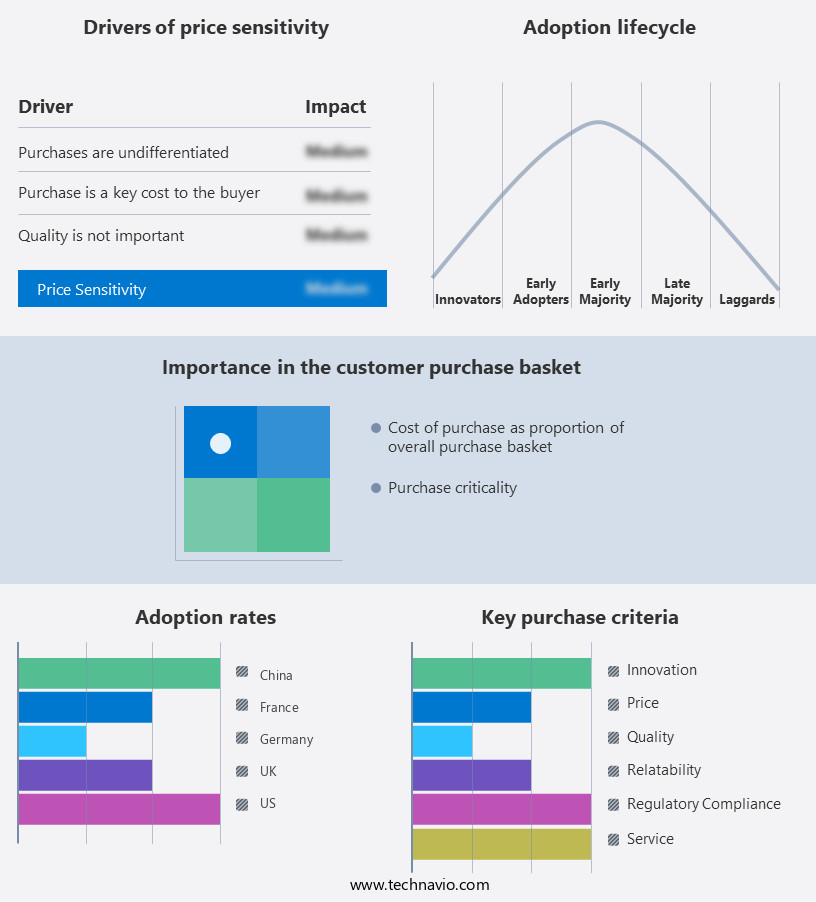
Customer Landscape of Smart Yoga Mat Industry
Competitive Landscape & Market Insights
Companies are implementing various strategies, such as strategic alliances, smart yoga mat market forecast, partnerships, mergers and acquisitions, geographical expansion, and product/service launches, to enhance their presence in the industry.
Sensing Tex SL - This company specializes in advanced yoga mat technology, featuring the Fitness Mat Dev Kit 1.9 and Wellness Mat Dev Kit 1.9.
The industry research and growth report includes detailed analyses of the competitive landscape of the market and information about key companies, including:
Qualitative and quantitative analysis of companies has been conducted to help clients understand the wider business environment as well as the strengths and weaknesses of key industry players. Data is qualitatively analyzed to categorize companies as pure play, category-focused, industry-focused, and diversified; it is quantitatively analyzed to categorize companies as dominant, leading, strong, tentative, and weak.
Recent Development and News in Smart Yoga Mat Market
- In January 2024, Lululemon Athletica, a leading athletic apparel company, announced the launch of its smart yoga mat, the "Smart Align Mat," integrating pressure sensors to provide real-time alignment feedback during yoga practices (Lululemon Press Release, 2024).
- In March 2024, Mindbody, a leading technology platform for the wellness industry, partnered with JOOX, a popular music streaming service, to offer customized yoga classes and playlists, enhancing the user experience for smart yoga mat users (Mindbody Press Release, 2024).
- In May 2024, Huawei, a global technology leader, entered the market with the launch of its "Huawei Fit Mat," featuring advanced sensors and AI algorithms to analyze users' yoga poses and provide personalized feedback (Huawei Press Release, 2024).
- In April 2025, Amazon announced the acquisition of Body Labs, a pioneering digital body modeling company, to enhance its smart yoga mat offerings with more accurate body tracking and personalized coaching features (Amazon Press Release, 2025).
Dive into Technavio's robust research methodology, blending expert interviews, extensive data synthesis, and validated models for unparalleled Smart Yoga Mat Market insights. See full methodology.
|
Market Scope
|
|
Report Coverage
|
Details
|
|
Page number
|
178
|
|
Base year
|
2024
|
|
Historic period
|
2019-2023 |
|
Forecast period
|
2025-2029
|
|
Growth momentum & CAGR
|
Accelerate at a CAGR of 6.8%
|
|
Market growth 2025-2029
|
USD 184.4 million
|
|
Market structure
|
Concentrated
|
|
YoY growth 2024-2025(%)
|
5.9
|
|
Key countries
|
US, Canada, China, UK, Germany, Japan, India, Italy, Brazil, and France
|
|
Competitive landscape
|
Leading Companies, Market Positioning of Companies, Competitive Strategies, and Industry Risks
|
Request Free Sample
Research Analyst Overview
- In the dynamic and evolving world of fitness technology, smart yoga mats continue to gain traction, offering enhanced features designed to optimize user experience. These advanced mats are engineered with sweat and odor resistance, ensuring a hygienic practice environment. The integration of improved balance and increased stability features allows for better alignment and increased focus during workouts. One of the key advancements in smart yoga mat technology is the use of open-cell foam and moisture absorption capabilities. These features provide superior cushioning and support, enhancing muscle recovery and overall comfort. Additionally, surface texture variations cater to various preferences and needs, offering a more personalized practice.
- Eco-friendly materials, such as TPE and natural rubber, are increasingly popular in the market. These mats not only prioritize sustainability but also undergo rigorous durability testing to ensure long-lasting performance. Mat design innovations include alignment markers, easy cleaning, and non-slip surfaces, catering to the evolving needs of yoga practitioners. Moreover, smart yoga mats now come with folding mechanisms, tear resistance, and joint protection, making them more versatile and accessible. Mat cushioning and mat thickness variations offer customized support for different body types and preferences. Furthermore, UV resistance and mat weight considerations ensure that these mats can be used in various environments and conditions.
- The yoga mat material landscape is diverse, with options ranging from closed-cell foam to PVC-free alternatives. Each material offers unique benefits, such as enhanced grip performance, mat lifespan, and mat dimensions. The integration of these features and materials reflects the continuous advancements in smart yoga mat technology, providing a more immersive and effective practice experience.
What are the Key Data Covered in this Smart Yoga Mat Market Research and Growth Report?
-
What is the expected growth of the Smart Yoga Mat Market between 2025 and 2029?
-
What segmentation does the market report cover?
-
The report segmented by Distribution Channel (Offline and Online), Material (Polyvinyl chloride (PVC), Thermoplastic elastomer (TPE), Natural rubber, Polyurethane (PU), and Others), Application (Home use, Yoga studios and fitness centers, Rehabilitation and therapy, and Others), and Geography (North America, Europe, APAC, South America, and Middle East and Africa)
-
Which regions are analyzed in the report?
-
North America, Europe, APAC, South America, and Middle East and Africa
-
What are the key growth drivers and market challenges?
-
Who are the major players in the Smart Yoga Mat Market?
Market Research Insights
- The market encompasses a diverse range of innovative products, characterized by advanced design features and enhanced functional properties. According to industry estimates, the market for smart yoga mats experienced a significant 15% year-over-year growth in 2021, driven by increasing consumer demand for tech-integrated fitness solutions. Mat construction varies from traditional PVC to eco-friendly, biodegradable materials, with manufacturers prioritizing mat hygiene, user experience, and allergen-free materials. Customer feedback highlights the importance of mat comfort, with a preference for high-density mats offering superior cushioning and support. Mat thickness also plays a crucial role, with thinner mats providing greater portability and easier storage, while thicker options offer improved stability and durability.
- Quality control is paramount, ensuring consistent mat longevity and safety, with manufacturers employing rigorous testing and manufacturing processes. In contrast, mat sustainability and recyclable materials have emerged as key differentiators, with some brands offering mats made from renewable resources and closed-loop manufacturing processes. Mat safety is another critical consideration, with manufacturers focusing on edge sealing and material sourcing to minimize potential health risks. The market continues to evolve, with new design innovations, material advancements, and user-centric features shaping its future.
We can help! Our analysts can customize this smart yoga mat market research report to meet your requirements.
Get in touch
1 Executive Summary
- 1.1 Market overview
- Executive Summary - Chart on Market Overview
- Executive Summary - Data Table on Market Overview
- Executive Summary - Chart on Global Market Characteristics
- Executive Summary - Chart on Market by Geography
- Executive Summary - Chart on Market Segmentation by Distribution Channel
- Executive Summary - Chart on Market Segmentation by Material
- Executive Summary - Chart on Market Segmentation by Application
- Executive Summary - Chart on Incremental Growth
- Executive Summary - Data Table on Incremental Growth
- Executive Summary - Chart on Company Market Positioning
2 Technavio Analysis
- 2.1 Analysis of price sensitivity, lifecycle, customer purchase basket, adoption rates, and purchase criteria
- Analysis of price sensitivity, lifecycle, customer purchase basket, adoption rates, and purchase criteria
- 2.2 Criticality of inputs and Factors of differentiation
- Overview on criticality of inputs and factors of differentiation
- 2.3 Factors of disruption
- Overview on factors of disruption
- 2.4 Impact of drivers and challenges
- Impact of drivers and challenges in 2024 and 2029
3 Market Landscape
- 3.1 Market ecosystem
- Parent Market
- Data Table on - Parent Market
- 3.2 Market characteristics
- Market characteristics analysis
4 Market Sizing
- 4.1 Market definition
- Offerings of companies included in the market definition
- 4.2 Market segment analysis
- 4.4 Market outlook: Forecast for 2024-2029
- Chart on Global - Market size and forecast 2024-2029 ($ million)
- Data Table on Global - Market size and forecast 2024-2029 ($ million)
- Chart on Global Market: Year-over-year growth 2024-2029 (%)
- Data Table on Global Market: Year-over-year growth 2024-2029 (%)
5 Historic Market Size
- 5.1 Global Smart Yoga Mat Market 2019 - 2023
- Historic Market Size - Data Table on Global Smart Yoga Mat Market 2019 - 2023 ($ million)
- 5.2 Distribution Channel segment analysis 2019 - 2023
- Historic Market Size - Distribution Channel Segment 2019 - 2023 ($ million)
- 5.3 Material segment analysis 2019 - 2023
- Historic Market Size - Material Segment 2019 - 2023 ($ million)
- 5.4 Application segment analysis 2019 - 2023
- Historic Market Size - Application Segment 2019 - 2023 ($ million)
- 5.5 Geography segment analysis 2019 - 2023
- Historic Market Size - Geography Segment 2019 - 2023 ($ million)
- 5.6 Country segment analysis 2019 - 2023
- Historic Market Size - Country Segment 2019 - 2023 ($ million)
6 Qualitative Analysis
- 6.1 Impact of AI on Global Smart Yoga Mat Market
7 Five Forces Analysis
- 7.1 Five forces summary
- Five forces analysis - Comparison between 2024 and 2029
- 7.2 Bargaining power of buyers
- Bargaining power of buyers - Impact of key factors 2024 and 2029
- 7.3 Bargaining power of suppliers
- Bargaining power of suppliers - Impact of key factors in 2024 and 2029
- 7.4 Threat of new entrants
- Threat of new entrants - Impact of key factors in 2024 and 2029
- 7.5 Threat of substitutes
- Threat of substitutes - Impact of key factors in 2024 and 2029
- 7.6 Threat of rivalry
- Threat of rivalry - Impact of key factors in 2024 and 2029
- 7.7 Market condition
- Chart on Market condition - Five forces 2024 and 2029
8 Market Segmentation by Distribution Channel
- 8.1 Market segments
- Chart on Distribution Channel - Market share 2024-2029 (%)
- Data Table on Distribution Channel - Market share 2024-2029 (%)
- 8.2 Comparison by Distribution Channel
- Chart on Comparison by Distribution Channel
- Data Table on Comparison by Distribution Channel
- 8.3 Offline - Market size and forecast 2024-2029
- Chart on Offline - Market size and forecast 2024-2029 ($ million)
- Data Table on Offline - Market size and forecast 2024-2029 ($ million)
- Chart on Offline - Year-over-year growth 2024-2029 (%)
- Data Table on Offline - Year-over-year growth 2024-2029 (%)
- 8.4 Online - Market size and forecast 2024-2029
- Chart on Online - Market size and forecast 2024-2029 ($ million)
- Data Table on Online - Market size and forecast 2024-2029 ($ million)
- Chart on Online - Year-over-year growth 2024-2029 (%)
- Data Table on Online - Year-over-year growth 2024-2029 (%)
- 8.5 Market opportunity by Distribution Channel
- Market opportunity by Distribution Channel ($ million)
- Data Table on Market opportunity by Distribution Channel ($ million)
9 Market Segmentation by Material
- 9.1 Market segments
- Chart on Material - Market share 2024-2029 (%)
- Data Table on Material - Market share 2024-2029 (%)
- 9.2 Comparison by Material
- Chart on Comparison by Material
- Data Table on Comparison by Material
- 9.3 Polyvinyl chloride (PVC) - Market size and forecast 2024-2029
- Chart on Polyvinyl chloride (PVC) - Market size and forecast 2024-2029 ($ million)
- Data Table on Polyvinyl chloride (PVC) - Market size and forecast 2024-2029 ($ million)
- Chart on Polyvinyl chloride (PVC) - Year-over-year growth 2024-2029 (%)
- Data Table on Polyvinyl chloride (PVC) - Year-over-year growth 2024-2029 (%)
- 9.4 Thermoplastic elastomer (TPE) - Market size and forecast 2024-2029
- Chart on Thermoplastic elastomer (TPE) - Market size and forecast 2024-2029 ($ million)
- Data Table on Thermoplastic elastomer (TPE) - Market size and forecast 2024-2029 ($ million)
- Chart on Thermoplastic elastomer (TPE) - Year-over-year growth 2024-2029 (%)
- Data Table on Thermoplastic elastomer (TPE) - Year-over-year growth 2024-2029 (%)
- 9.5 Natural rubber - Market size and forecast 2024-2029
- Chart on Natural rubber - Market size and forecast 2024-2029 ($ million)
- Data Table on Natural rubber - Market size and forecast 2024-2029 ($ million)
- Chart on Natural rubber - Year-over-year growth 2024-2029 (%)
- Data Table on Natural rubber - Year-over-year growth 2024-2029 (%)
- 9.6 Polyurethane (PU) - Market size and forecast 2024-2029
- Chart on Polyurethane (PU) - Market size and forecast 2024-2029 ($ million)
- Data Table on Polyurethane (PU) - Market size and forecast 2024-2029 ($ million)
- Chart on Polyurethane (PU) - Year-over-year growth 2024-2029 (%)
- Data Table on Polyurethane (PU) - Year-over-year growth 2024-2029 (%)
- 9.7 Others - Market size and forecast 2024-2029
- Chart on Others - Market size and forecast 2024-2029 ($ million)
- Data Table on Others - Market size and forecast 2024-2029 ($ million)
- Chart on Others - Year-over-year growth 2024-2029 (%)
- Data Table on Others - Year-over-year growth 2024-2029 (%)
- 9.8 Market opportunity by Material
- Market opportunity by Material ($ million)
- Data Table on Market opportunity by Material ($ million)
10 Market Segmentation by Application
- 10.1 Market segments
- Chart on Application - Market share 2024-2029 (%)
- Data Table on Application - Market share 2024-2029 (%)
- 10.2 Comparison by Application
- Chart on Comparison by Application
- Data Table on Comparison by Application
- 10.3 Home use - Market size and forecast 2024-2029
- Chart on Home use - Market size and forecast 2024-2029 ($ million)
- Data Table on Home use - Market size and forecast 2024-2029 ($ million)
- Chart on Home use - Year-over-year growth 2024-2029 (%)
- Data Table on Home use - Year-over-year growth 2024-2029 (%)
- 10.4 Yoga studios and fitness centers - Market size and forecast 2024-2029
- Chart on Yoga studios and fitness centers - Market size and forecast 2024-2029 ($ million)
- Data Table on Yoga studios and fitness centers - Market size and forecast 2024-2029 ($ million)
- Chart on Yoga studios and fitness centers - Year-over-year growth 2024-2029 (%)
- Data Table on Yoga studios and fitness centers - Year-over-year growth 2024-2029 (%)
- 10.5 Rehabilitation and therapy - Market size and forecast 2024-2029
- Chart on Rehabilitation and therapy - Market size and forecast 2024-2029 ($ million)
- Data Table on Rehabilitation and therapy - Market size and forecast 2024-2029 ($ million)
- Chart on Rehabilitation and therapy - Year-over-year growth 2024-2029 (%)
- Data Table on Rehabilitation and therapy - Year-over-year growth 2024-2029 (%)
- 10.6 Others - Market size and forecast 2024-2029
- Chart on Others - Market size and forecast 2024-2029 ($ million)
- Data Table on Others - Market size and forecast 2024-2029 ($ million)
- Chart on Others - Year-over-year growth 2024-2029 (%)
- Data Table on Others - Year-over-year growth 2024-2029 (%)
- 10.7 Market opportunity by Application
- Market opportunity by Application ($ million)
- Data Table on Market opportunity by Application ($ million)
11 Customer Landscape
- 11.1 Customer landscape overview
- Analysis of price sensitivity, lifecycle, customer purchase basket, adoption rates, and purchase criteria
12 Geographic Landscape
- 12.1 Geographic segmentation
- Chart on Market share by geography 2024-2029 (%)
- Data Table on Market share by geography 2024-2029 (%)
- 12.2 Geographic comparison
- Chart on Geographic comparison
- Data Table on Geographic comparison
- 12.3 North America - Market size and forecast 2024-2029
- Chart on North America - Market size and forecast 2024-2029 ($ million)
- Data Table on North America - Market size and forecast 2024-2029 ($ million)
- Chart on North America - Year-over-year growth 2024-2029 (%)
- Data Table on North America - Year-over-year growth 2024-2029 (%)
- 12.4 Europe - Market size and forecast 2024-2029
- Chart on Europe - Market size and forecast 2024-2029 ($ million)
- Data Table on Europe - Market size and forecast 2024-2029 ($ million)
- Chart on Europe - Year-over-year growth 2024-2029 (%)
- Data Table on Europe - Year-over-year growth 2024-2029 (%)
- 12.5 APAC - Market size and forecast 2024-2029
- Chart on APAC - Market size and forecast 2024-2029 ($ million)
- Data Table on APAC - Market size and forecast 2024-2029 ($ million)
- Chart on APAC - Year-over-year growth 2024-2029 (%)
- Data Table on APAC - Year-over-year growth 2024-2029 (%)
- 12.6 South America - Market size and forecast 2024-2029
- Chart on South America - Market size and forecast 2024-2029 ($ million)
- Data Table on South America - Market size and forecast 2024-2029 ($ million)
- Chart on South America - Year-over-year growth 2024-2029 (%)
- Data Table on South America - Year-over-year growth 2024-2029 (%)
- 12.7 Middle East and Africa - Market size and forecast 2024-2029
- Chart on Middle East and Africa - Market size and forecast 2024-2029 ($ million)
- Data Table on Middle East and Africa - Market size and forecast 2024-2029 ($ million)
- Chart on Middle East and Africa - Year-over-year growth 2024-2029 (%)
- Data Table on Middle East and Africa - Year-over-year growth 2024-2029 (%)
- 12.8 US - Market size and forecast 2024-2029
- Chart on US - Market size and forecast 2024-2029 ($ million)
- Data Table on US - Market size and forecast 2024-2029 ($ million)
- Chart on US - Year-over-year growth 2024-2029 (%)
- Data Table on US - Year-over-year growth 2024-2029 (%)
- 12.9 Canada - Market size and forecast 2024-2029
- Chart on Canada - Market size and forecast 2024-2029 ($ million)
- Data Table on Canada - Market size and forecast 2024-2029 ($ million)
- Chart on Canada - Year-over-year growth 2024-2029 (%)
- Data Table on Canada - Year-over-year growth 2024-2029 (%)
- 12.10 China - Market size and forecast 2024-2029
- Chart on China - Market size and forecast 2024-2029 ($ million)
- Data Table on China - Market size and forecast 2024-2029 ($ million)
- Chart on China - Year-over-year growth 2024-2029 (%)
- Data Table on China - Year-over-year growth 2024-2029 (%)
- 12.11 UK - Market size and forecast 2024-2029
- Chart on UK - Market size and forecast 2024-2029 ($ million)
- Data Table on UK - Market size and forecast 2024-2029 ($ million)
- Chart on UK - Year-over-year growth 2024-2029 (%)
- Data Table on UK - Year-over-year growth 2024-2029 (%)
- 12.12 Japan - Market size and forecast 2024-2029
- Chart on Japan - Market size and forecast 2024-2029 ($ million)
- Data Table on Japan - Market size and forecast 2024-2029 ($ million)
- Chart on Japan - Year-over-year growth 2024-2029 (%)
- Data Table on Japan - Year-over-year growth 2024-2029 (%)
- 12.13 Germany - Market size and forecast 2024-2029
- Chart on Germany - Market size and forecast 2024-2029 ($ million)
- Data Table on Germany - Market size and forecast 2024-2029 ($ million)
- Chart on Germany - Year-over-year growth 2024-2029 (%)
- Data Table on Germany - Year-over-year growth 2024-2029 (%)
- 12.14 India - Market size and forecast 2024-2029
- Chart on India - Market size and forecast 2024-2029 ($ million)
- Data Table on India - Market size and forecast 2024-2029 ($ million)
- Chart on India - Year-over-year growth 2024-2029 (%)
- Data Table on India - Year-over-year growth 2024-2029 (%)
- 12.15 Brazil - Market size and forecast 2024-2029
- Chart on Brazil - Market size and forecast 2024-2029 ($ million)
- Data Table on Brazil - Market size and forecast 2024-2029 ($ million)
- Chart on Brazil - Year-over-year growth 2024-2029 (%)
- Data Table on Brazil - Year-over-year growth 2024-2029 (%)
- 12.16 France - Market size and forecast 2024-2029
- Chart on France - Market size and forecast 2024-2029 ($ million)
- Data Table on France - Market size and forecast 2024-2029 ($ million)
- Chart on France - Year-over-year growth 2024-2029 (%)
- Data Table on France - Year-over-year growth 2024-2029 (%)
- 12.17 Italy - Market size and forecast 2024-2029
- Chart on Italy - Market size and forecast 2024-2029 ($ million)
- Data Table on Italy - Market size and forecast 2024-2029 ($ million)
- Chart on Italy - Year-over-year growth 2024-2029 (%)
- Data Table on Italy - Year-over-year growth 2024-2029 (%)
- 12.18 Market opportunity by geography
- Market opportunity by geography ($ million)
- Data Tables on Market opportunity by geography ($ million)
13 Drivers, Challenges, and Opportunity/Restraints
- 13.3 Impact of drivers and challenges
- Impact of drivers and challenges in 2024 and 2029
- 13.4 Market opportunities/restraints
14 Competitive Landscape
- 14.2 Competitive Landscape
- Overview on criticality of inputs and factors of differentiation
- 14.3 Landscape disruption
- Overview on factors of disruption
- 14.4 Industry risks
- Impact of key risks on business
15 Competitive Analysis
- 15.2 Company ranking index
- 15.3 Market positioning of companies
- Matrix on companies position and classification
- 15.4 Sensing Tex SL
- Sensing Tex SL - Overview
- Sensing Tex SL - Product / Service
- Sensing Tex SL - Key offerings
- SWOT
- 15.5 YogiFi
- YogiFi - Overview
- YogiFi - Product / Service
- YogiFi - Key offerings
- SWOT
16 Appendix
- 16.2 Inclusions and exclusions checklist
- Inclusions checklist
- Exclusions checklist
- 16.3 Currency conversion rates for US$
- Currency conversion rates for US$
- 16.4 Research methodology
- 16.7 Validation techniques employed for market sizing
- Validation techniques employed for market sizing
- 16.9 360 degree market analysis
- 360 degree market analysis
- 16.10 List of abbreviations







![]() Get the report (PDF) sent to your email within minutes.
Get the report (PDF) sent to your email within minutes.
Complimentary full Excel data with your report purchase.